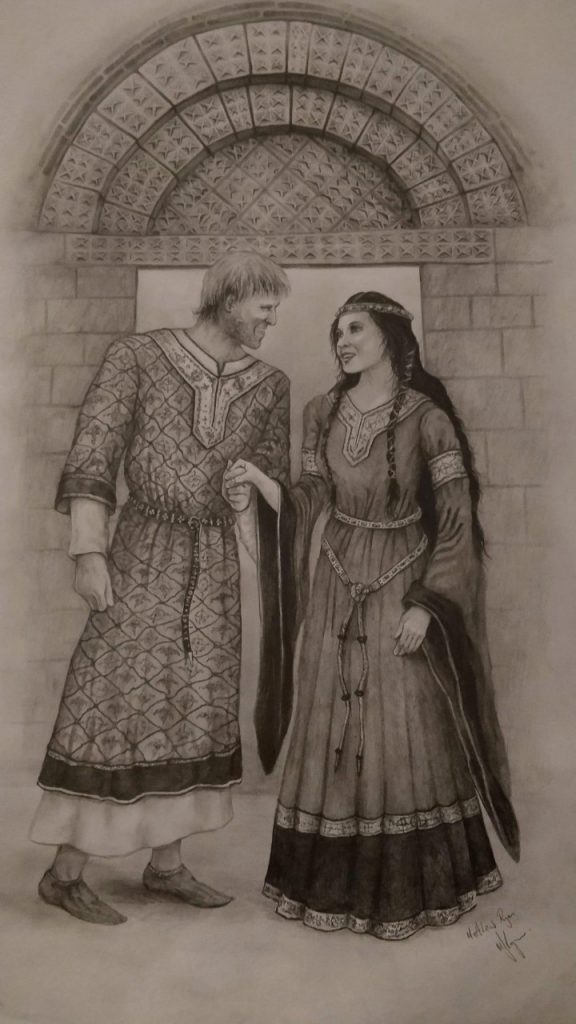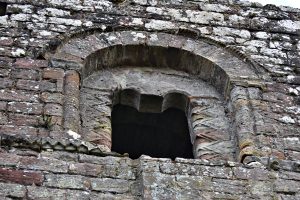
Illustration by Matthew Ryan of Richard de Clare and Aoife Ni Murchada, meeting under the door arch at Chepstow Castle.
When I decided I was going to write the story of Richard de Clare and Aoife MachMurchada, I had no idea of the digging I would have to do to find out anything about the historical Aoife (pronounced Ee-fa) and what a mystery she was, not to mention the false trails that exist in the mainstream, including in this case Wikipedia, where the entry for Aoife is unreliable with several wrong details. It is very difficult finding accurate source material.
I had written about Aoife before as an older lady and William Marshal’s mother in law in my novel The Scarlet Lion. During that research, I had discovered that no one was exactly sure of her death date. She supposedly disappears from the record in the mid 1180’s but the evidence is not precise and she may actually have lived much longer. No exact birth date is forthcoming for Aoife either, although 1152 is a reasonable circa date and the one I used for the novel. She was one of two known children born to Diarmait MachMurchada, King of Leinster and his third wife Mór Ní Thuathail. He had other sons and daughters born of earlier relationships but it would appear that Mór was the ‘officially recognised’ wife. The second known child was a son, Conchobar (pronounced Connor). Mór’s half brother, Lorcan, was a priest and rose to become Archbishop of Dublin. Forty five years later he was canonised and his heart tomb can still be visited in Christchurch Cathedral, Dublin.
Aoife would have been in her early teens when her father ran into a spot of more than usual bother with his enemies and rivals and had to flee the country, burning his palace of Ferns behind him as he ran. He took his family with him into exile, his first port of call being Bristol and the merchant, fixer, and nobleman Robert FitzHarding.
Diarmait probably already knew FitzHarding through mercantile dealings and political exchanges from the Anarchy days between Stephen and Matilda, when Diarmait had aided the Angevin cause. Now it was to stand him in good stead as FitzHarding sent him to King Henry II with recommendations. Did Aoife and her mother go with Diarmait, or remain with FitHarding in Bristol? We don’t know, but they may well have been in his entourage. Certainly there is later circumstantial evidence that Henry had a soft spot for Aoife, and we know that he had a particular eye for pretty teenage girls.
The upshot of the meeting was that Henry gave Diarmait permission to recruit mercenaries to help him retrieve Leinster from his enemies. Diarmait returned to Bristol with permission and set about the task. FitzHarding brokered a meeting between Richard de Clare, lord of Striguil (now called Chepstow) and the Irish contingent, suggesting (from what we can suss), that de Clare might be interested in project-managing the task with an eye to his own involvement and profit.
Richard de Clare and Henry II were on uneasy terms. De Clare’s father had been on the opposing side during the Stephen-Matilda Anarchy and de Clare himself, around the same age as Henry II and related to him in the distant past, was a powerful lord whom Henry needed to keep under the thumb. De Clare, kicking his heels and being denied a place in the sun of Henry’s patronage was very interested in the idea of pastures new. He was also nobody’s fool and was not prepared to do Diarmait MachMurchada’s dirty work unless given a foothold in Ireland. He and Diarmait drove a hard bargain at the negotiating table, part of which was Diarmait’s oath that when Richard set foot in Ireland and made good on his promise to retake Leinster, then he would have lands to settle and he would have Aoife to wife. It should be taken into account that Aoife herself, as Richard de Clare’s spouse, would receive a dower portion of a third of Richard’s non Irish lands as part of the marriage agreement should he predecease her, and any children she bore would be heirs to everything – a detail sometimes overlooked by historians. This was always a two-way deal.
Where the bargain was struck we do not know, it could have been at Bristol, but it could also have been at Striguil, Richard’s great castle on the River Wye. At the time of the agreement, Richard was in his 30’s and Aoife would have been about fourteen. What she thought about the arrangement between her father and Richard de Clare we do not know, but I have sought to imagine her responses in The Irish Princess.
It would be another three years before Richard came to Ireland and made good on his promise. He and Aoife were married in Waterford in September 1170 by which time she would have been in her late teens. Indeed, the age gap was similar or slightly less to that between William Marshal and Isabelle de Clare. The event was commemorated in a painting by Daniel Maclise in 1854 and can be viewed in the National Gallery of Ireland in Dublin. Click here to see the painting There’s a water colour version too, showing Aoife with blond hair. Click here to view We don’t know what Aoife looked like. There seems to be a notion that she had red hair but this is linked to the story of ‘Aoife Rua’ (Red Aoife) a totally unconnected mythical lady from Ulster who often gets mixed up/entwined with the Aoife, daughter of Diarmait MacMurchada wife of Richard de Clare (who was a red-head himself, with freckles and light eyes, according to a description by contemporary chronicler Gerald of Wales). In my story Aoife has dark hair and green eyes. I deliberately wanted to avoid the ‘Red Aoife’ trope.
Aoife and Richard had two children. Isabelle, who was to marry the great William Marshal in 1189, and Gilbert, who died, very possibly at Haverford in Wales some time around 1184, leaving his sister as sole heiress to the vast de Clare and Machmurchada inheritances.
Richard died in 1176 and Aoife’s life becomes both interesting and obscure from here. Part of that interesting element comes from the obscurity of the little we can piece together. There is only one mention of her in Leinster and that is in the copy of a charter, although the date of that charter is questionable and the dateline ranges between the mid 1180’s to the mid 1190’s after her daughter Isabelle’s marriage to William Marshal.
It would seem that she left Leinster and came to Striguil after Richard’s death. Historian Marie Therese Flanagan says that there is a possibility that Aoife ‘retained control of the Marcher lordship of Striguil from 1176 to 1184’ after which Henry took over because of an increasing threat from the Welsh. All the evidence points to Aoife making her home in England and the Welsh Marches, perhaps to safeguard her children’s non Irish heritage, and perhaps because it was safer than Ireland. There is a story of her meeting her demise in Ireland by being shot in the throat by a member of the rival Quinn family in 1188 but it is a total fabrication. Nor is she buried at Kilkenny as is sometimes suggested. That too is a myth.
Very interestingly, although Aoife was a young and nubile widow, Henry did not force her to remarry, and neither did Aoife show any intention of remarrying on her own account. She was content to be Richard de Clare’s widow. Generally if a widow remarried, her children were fostered out as wards, but it would seem from the scanty evidence, that Aoife kept her children with her or close by, at least up to the point that her son died on the cusp of his teens. After that, Isabelle was taken into custody at the Tower of London. It is again, interesting, that Aoife had the use of manors within an easy day’s ride of London in Hertfordshire and Essex and seems from the financial records of the time to have spent amounts of her widowhood here, very likely to be near Isabelle. I was unaware of this until I began researching THE IRISH PRINCESS, but it makes perfect sense.
I also came to realise during the writing that Henry II came to Ireland around the time that Isabelle de Clare was born. Given Richard de Clare’s efforts to ingratiate himself with the King at the time, and given Aoife’s proximity in all this, it led me to wonder through the medium of the novel whether Henry had a particular closer interest in little Isabelle de Clare, perhaps as a godfather.

A window in the old keep at Goodrich – the ‘Mac-Mac’ Tower with chevron decorations. Did Aoife look out from here on the bustle of Goodrich in the 12thc century?
Historian Paul Martin Remfry in his excellent work on Goodrich Castle suggests that Aoife may have survived until 1204 and lived at Goodrich Castle for a time. The oldest part of the castle, the keep, built in the 12th century has the nick-name of the ‘Mac-Mac’ Tower which is likely to be a derivative of MacMurchada. Certainly William Marshal did not obtain Goodrich until 1204, although Aoife disappears from the record albeit with a variable dateline, sometime in the late 1180’s to 90’s. Paul Martin Remfrey tells us she was still living in 1189 when Henry II died. Remfry notes that ‘No royal reference of maintenance has survived of Goodrich Castle in either the later reign of Henry II or King Richard. This suggests that the castle was maintained from local revenues but it may also suggest that the castle was under control of the lady Aoife.’
We know Aoife was buried at Tintern Abbey when she died, because there is a record from 1531 from the Visitations by the Heralds in Wales, that identifies Aoife’s tomb as being in the north section of the church. It has since been lost as have the tombs of her daughter Isabelle, and granddaughter Matilda and grandsons Walter and Ancel. Tintern lies a short distance from both Chepstow and Goodrich, which suggests that Aoife died locally. It is perhaps fitting that Richard de Clare lies in a tomb in Holy Trinity Dublin, in the land he came to conquer, and his Irish wife is buried on the Welsh borders, among lands that were part of her dowry and from which her offspring could expand. Aoife ni Murchada who played the game of survival politics and won. She may dwell in the shadows, but turn her way,and she is there, an Irish princess, waiting to step into the light.
Elizabeth Chadwick
………………………………………………………………………………………………………………………………………………………………………………………………………………………..

“This marvellous novel is a fierce contender for my novel of the year. It completely immerses the reader in these lives lived so long ago. It’s an incredible story, extremely well-researched and very, very moving.”
Kate Atherton, For Winter Nights Blog and reviewer for the Sunday Express
Amazon link to the title.